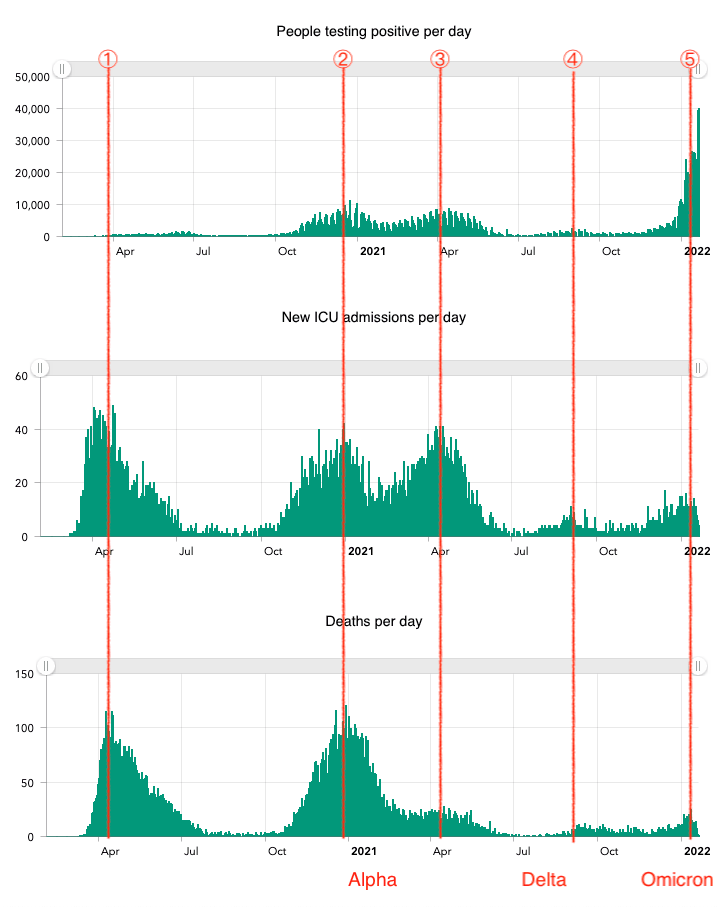Sweden: Three Key Parameters Since Early 2020
Overlaid are the five waves (red lines) and the predominant virus variant (red text)

Zero Deaths Projected By April-May
But actual death numbers still going up, except in Germany
After Britain, Ireland has also abolished the mask mandate. The up-to-then nice decline of the British incidence has since slowed down and the next weeks will tell if this trend continues. In this case, it would have been a premature move.
Should there be no other variant coming, spring could bring the much awaited relief. The new endemic situation, however, will not mean that we can throw caution over board and we will probably keep our masks for a while longer, especially on planes. The burden on our health systems, however, will ease; first by having fewer Covid-19 patients and, a few months later, by taking the pressure of the personnel, which will fall ill less frequently. There will also be focal outbreaks, particularly in places where people are in close contact, such as bars and clubs. There will also be people dying but with every month passing, this will become the same normal as have become the flu deaths each winter. In fact, it is to be expected that the flu and Covid-19 will thought of as rather similar.
For our leaders, 2022 should be the year to ready our communities for future pandemics. Given the continued overpopulation of our planet and the incessant thirst for moving goods and people around the globe, and with them the germs, the next pandemic can only become worse than this one. And if scientific predictions are to be believed, it will come earlier than we wish for.
| Daily Incidence | Daily ICU | Daily Deaths | Daily Pos. Rate | Cumulative Excess Death | Death Projection | |
|---|---|---|---|---|---|---|
| USA | 223.7 ↘︎ | 7.8 ↗︎ | 0.622 ↗︎ | 42.4 % ↑ | 16.0 % | ↓ |
| WA State | 207.2 ↘︎ | 3.0 ↗︎ | 0.319 ↗︎ | 10.9 % | ↗︎↓ | |
| Britain | 135.7 ↘︎ | 1.0 ↘︎ | 0.396 ↗︎ | 06.6 % ↓ | 13.0 % | ↓ |
| France | 518.3 ↗︎ | 5.7 → | 0.346 ↗︎ | 28.2 % ↑ | 12.4 % | ↓ |
| Germany | 118.9 ↑ | 3.2 ↘︎ | 0.198 ↓ | 25.8 % ↑ | 07.3 % | ↘︎ |
| Tunisia | 078.9 ↑ | 1.2 ↗︎ | 0.208 ↑ | 24.1 % ↑ | 18.8 % | ↗︎↓ |
Scientist have long proven that vaccines have had a positive effect on the course of the pandemic, predominantly on the avoidance of hospitalisations and deaths. But for many people, science is not easy to understand and humans are generally prone to simply look around themselves and to explain the world with what they see.
So let's look around. Well, not so close. Let's go to Sweden, which I had once included in the graphs because of its "different" handling of the pandemic: During their first wave, they essentially let their grandparents die (see my Remarks from September 20220), which makes it an interesting case for those who claim we should have not intervened at all because natural immunity to the virus would have kicked in eventually.
For my simplified explanation I use this screenshot from the official Swedish Health Authority's web site (link). Depicted are the daily development of the most important three key parameters: Incidence, ICU occupancy and Deaths.
Superimposed in red are the five waves:
- The first and second wave resulted in huge peaks for ICU and deaths because the virus hit a naïve population that had no immune protection whatsoever. The death peak of the first wave was 5x higher than the German one at that time because Sweden did not distance nor wear masks.
- The third wave in April 2021 had a similar peak incidence and peak ICU occupancy as the second wave but the death peak was 5x smaller. This reduction cannot be explained by the rise of natural immunity to the virus (through infection) alone, because it would have taken longer to develop than the four month since the second wave. The biggest reason for the steep reduction in deaths was thus the vaccination, which had started shortly after the second wave and the grandparents, that is those who died most, were vaccinated first.
- The fourth wave saw fewer people infected because the country did have, by then, distancing and masking rules in place. It was also the time of the Delta variant, to which the vaccine offered less protection from infection. But it still protected well against severe disease and death because compared to wave #1, which had a similar peak incidence, ICU and death peaks are greatly reduced.
- At the time of the fifth wave, Sweden had vaccinated >70% of its population (and 30% boosted), which gave them full protection against severe disease from the highly-spreading Omicron variant. Omicron's proliferation potential created a huge incidence peak, which is currently on the decline. But the ICU and peaks remains relatively small thanks to population immunity to the virus.
While some of the current immunity can be attributed to prior infections, the fact that more than ⅔ of those in the ICUs are come from the ⅓ of the Swedish population that is unvaccinated shows that vaccination plays a big role in the protection. A new report by USA's Centrers for Disease Control (CDC) shows that the unvaccinated are 5X more likely to get omicron than those boosted (ars technica).
Without vaccination, the fifth Swedish wave would have resulted in ICU and death peaks as high, if nor higher, than what we saw in wave #1 and #2.
In other words: A huge incidence + few hospitalisations and deaths = the vaccine works.